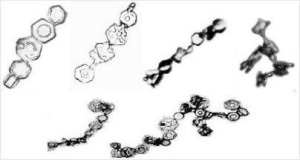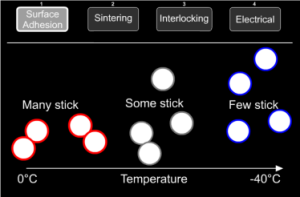Cloud Physics Research - Ice Crystal Aggregation
by Dr. Christopher Emersic

If ice crystals are allowed to grow for a sufficient amount of time, they will start to coalesce and form chains (Fig. 1). These chains of crystals are known as aggregates and have optical properties that are different to individual ice crystals. In particular, the anvils of equatorial thunderstorms have been shown to contain aggregates of horizontally aligned plates which act like mirrors, reflecting a lot of incoming radiation (which is intense at the equator and thus important to understand) (Liou, 1973; Ackermann et al. , 1988; Stephens et al., 1990; Hartmann et al., 1992; McFarquhar and Heymsfield, 1997). The reflection of solar radiation back into space by such ice clouds can have a significant cooling effect on the planet, countering the warming effect of greenhouse gases. This is discussed in more detail on the light scattering page. The reflective properties of the ice clouds containing a substantial aggregate presence can be better understood by learning about the properties of aggregates formed under a range of conditions. Aggregation is also an important process to consider in numerical models of cloud and precipitation processes.
There are a number of microphysical mechanisms conducive to the formation of aggregates. The adhesive properties of an ice crystal’s surface are related to its temperature. At higher temperatures closer to 0°C, the ice surfaces are ‘stickier’ increasing the chance of cohesion of two colliding ice crystals. As temperature reduces, the surfaces become colder and less sticky, and this makes aggregation less likely from this adhesive effect. Once two ice crystals have collided and stuck together, a process of sintering can act to glue the particles together. Sintering is the process whereby water molecules diffuse from a place of lower curvature (elsewhere on the surface) or the environment to a place of higher curvature (e.g. the boundary where two crystals meet). Another method by which ice crystals can stick together relies on the interlocking of different parts of their structure. For example, the multi-branching arms of dendritic crystals can more easily interlock if they collide than the relatively smooth faces of columnar or plate crystals. This process is therefore dependent on habit and thus temperature and humidity values conducive to such shape formation. Experimental work has shown that at -12°C (and in general between -10 and -15°C), there is an increased occurrence of aggregation attributed to this effect (Hobbs et al. 1974). One final aggregation mechanism relates to the coalescence of ice crystals in the presence of high electric fields—such as those found in thunderstorms. Research has shown that while such fields do not increase the attraction of crystals together from distances, it does allow crystals to remain connected on collision for long enough to allow the sintering process to ‘glue’ them together. This electrical effect is independent of temperature unlike the adhesive effect associated with the surface properties of ice, as discussed earlier (Latham and Saunders, 1970a,b). Greater numbers of crystals present in a cloud also increase the probability of aggregation between then; more crystals means an increasing chance of any two of them colliding. These processes are illustrated in Fig. 2.

In the laboratory studies to be carried out in the Manchester Ice Cloud Chamber, we aim to quantify ice crystal aggregation as a function of cloud temperature. The physical properties of the ice crystals can be measured using the Cloud Particle Imager (CPI) and help identify their sticking and collision efficiencies. Aggregates form readily in the 10 m high cloud chamber. Clouds of supercooled water droplets are grown and nucleated at the top (turned into ice crystals), and the substantial vertical height of the chamber allows sufficient growth time for crystal coalescence to occur and the formation of chain aggregates. The aggregates formed are then measured by the CPI as they fall to the base of the chamber, and their properties such as length and structure as a function of the ambient temperature can be measured.
References:
Ackermann, T. P., Liou, K. N., Valero, F. P. J., and Pfister, L., 1988, Heating rates in tropical anvils., J. Atmos. Sci., 45, 1606-1623.
Hartman, D. L., Ockert-Bell, M. E., and Michelsen, M. L., 1992, The effect of cloud type on the earth’s energy balance: Global analysis., J. Climate, 5, 1281–1304.
Hobbs, P., S. Chang, and J. Locatelli, 1974: The dimension and aggregation of ice crystals in natural clouds. J. Geophys. Res., 79,2199–2206.
Latham, J., Saunders, C. P. R., 1970a, Experimental measurements of the collection efficiencies of ice crystals in electric fields. Q. J. R. Meteorol. Soc., 96,257–265.
Latham, J., Saunders, C. P. R., 1970b, The electrostatic forces on charged ice crystals separated by small distances in an electric field. Q. J. R. Meteorol. Soc., 96,266–272
Liou, K. N., 1973, Transfer of solar irradiance through cirrus cloud layers., J. Geophys. Res., 78, 1409–1418.
McFarquhar, G. M., and Heymsfield, A. J., 1997, Parameterization of tropical cirrus ice crystal size distributions and implications for radiative transfer: Results from cepex., J. Atmos. Sci., 54, 2187–2200.
Saunders, C. P. R. and Wahab, N. M. A., 1975, The influence of electric fields on the aggregation of ice crystals, J. Meteorol. Soc. Jpn., 53, 121–126.
Stephens, G. L., Tsay, S., Stackhouse, P. W., and Flatau, P. J., 1990, The relevance of the microphysical and radiative properties of cirrus clouds to climate and climatic feedback., J. Atmos. Sci., 47, 1742–1753.
Wahab, N. M. A., 1974, ‘Ice crystal interactions in electric fields’, PhD thesis, UMIST.